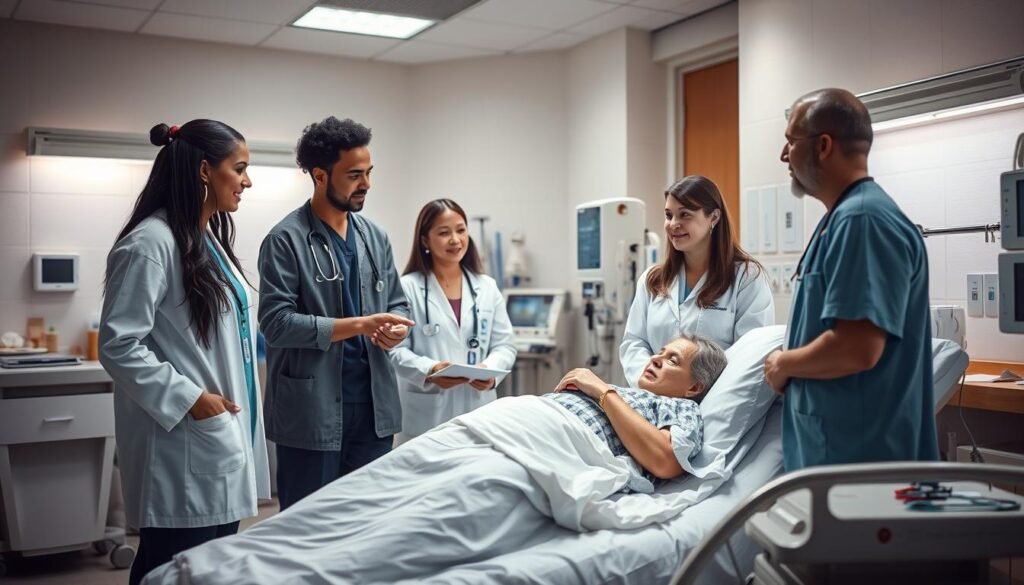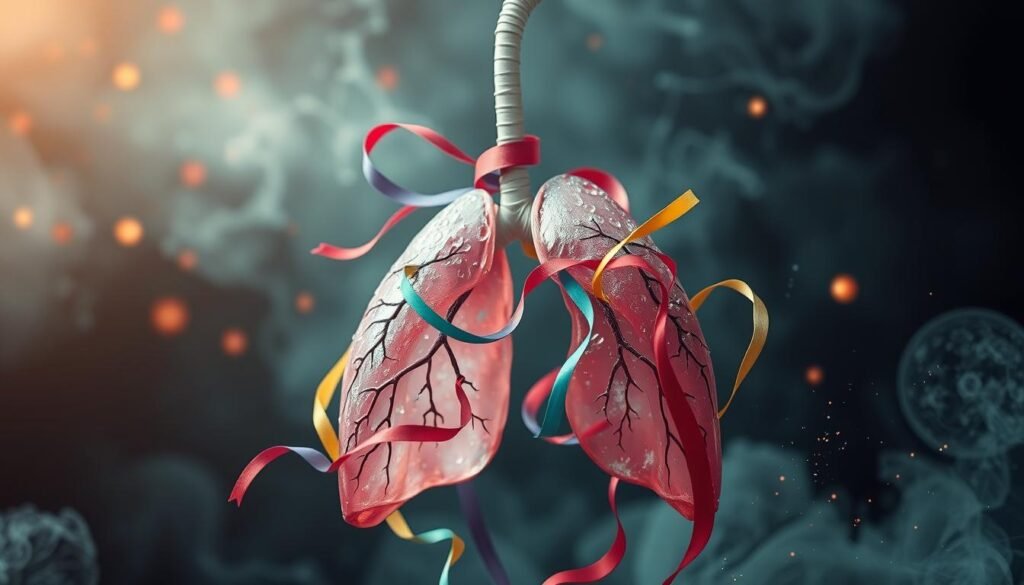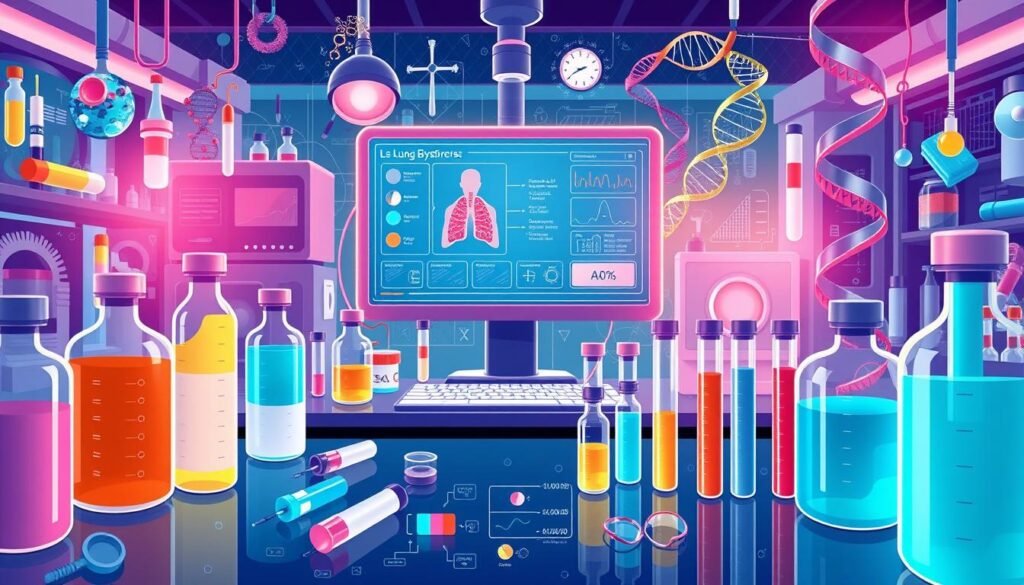Almost 75% of people with lung cancer will have chemotherapy. It’s key to their care. Knowing the different chemotherapies is vital. These treatments target cancer cells and boost overall therapy success. Chemotherapy is central for treating both small cell lung cancer (SCLC) and non-small cell lung cancer (NSCLC). It helps kill cancer cells all over the body.
We will explore the varieties of chemotherapy regimens. We’ll look at combination therapies and single-agent treatments. Also, we’ll discuss the common chemotherapy drugs for lung cancer. Treatments are customized for each person. They consider the cancer’s type and stage, and the patient’s overall health.
Key Takeaways
- Nearly 75% of lung cancer patients receive chemotherapy as part of their treatment.
- Combination therapies enhance the effectiveness of chemotherapy drugs.
- Personalized treatment plans are crucial for effective lung cancer management.
- Understanding the types of chemotherapy aids patients in making informed decisions.
- Both systemic and targeted approaches are considered in chemotherapy.
- Common drugs like cisplatin and carboplatin are frequently employed in regimens.
Introduction to Lung Cancer Chemotherapy
Chemotherapy for lung cancer uses drugs to kill cancer cells. It’s key at different lung cancer stages. Many patients choose it. In hospitals, doctors give chemotherapy through the veins, and it takes hours. Each treatment cycle is three to four weeks long. This gives the body time to heal between doses.
The type of chemotherapy used depends on the lung cancer’s form. About 15% of cases are small-cell lung cancer (SCLC). For SCLC, doctors often use the EP protocol. This combines etoposide with cisplatin or carboplatin. On the other hand, non-small-cell lung cancer (NSCLC) makes up about 90% of cases. NSCLC treatments often mix cisplatin or carboplatin with drugs like docetaxel, gemcitabine, or pemetrexed.
During chemotherapy, patients face a tough period called the nadir. This is when blood cell counts are very low. It can cause side effects like nausea, vomiting, and peripheral neuropathy. Knowing how chemotherapy works is crucial to managing lung cancer. It shows why ongoing research is important. Scientists study tumor growth and genetic changes to help patients.
Understanding Chemotherapy
Chemotherapy is key in fighting lung cancer. It uses drugs to destroy cancer cells. These drugs are often given through the veins, but some can be taken as pills. Chemotherapy and radiation therapy often work together to fight cancer more effectively.
After a lung cancer diagnosis, most patients start chemotherapy right away. For example, one patient had chemotherapy every three weeks for four years. Within eighteen months, their cancer had shrunk a lot. This is especially important for small cell lung cancer (SCLC), which is often found at a late stage. For SCLC, doctors usually use etoposide and platinum-based drugs like cisplatin or carboplatin.
Chemotherapy can also treat cancer that has spread beyond the lungs. This makes it useful for advanced lung cancer. However, it can harm healthy cells too. This can lead to side effects such as hair loss, nausea, extreme fatigue, fever, and a higher risk of infections. Most side effects get better three weeks after treatment, but some can last longer.
Doctors use tests like chest x-rays or CT scans to see how well chemotherapy is working. These tests usually happen after two or three rounds of treatment. They look for signs like less coughing or breathlessness. These signs mean the treatment is working.
| Chemotherapy Drug | Type of Lung Cancer | Common Use |
|---|---|---|
| Cisplatin | Non-Small Cell Lung Cancer | First-line treatment, often combined with other drugs |
| Carboplatin | Non-Small Cell Lung Cancer | Used similarly to Cisplatin |
| Etoposide | Small Cell Lung Cancer | First-line combination therapy with a platinum drug |
| Topotecan | Small Cell Lung Cancer | Second or third-line treatment option |
| Pemetrexed | Non-Small Cell Lung Cancer | Often combined with platinum-based chemotherapy |
| Vinorelbine | Non-Small Cell Lung Cancer | Commonly used in conjunction with platinum drugs |
Types of Chemotherapy for Lung Cancer
Chemotherapy is key in treating lung cancer, offering types of chemotherapy for lung cancer to fit different needs. We look into two main methods: combination chemotherapy and single-agent chemotherapy. These help fight the disease in various ways.
Combination Chemotherapy
Combination chemotherapy uses more than one drug to boost treatment results. It works great for non-small cell lung cancer (NSCLC). Drugs like cisplatin with gemcitabine or docetaxel are common choices. They help by attacking cancer from different angles. This makes it tough for cancer to resist the drugs.
Many lung cancer chemotherapy regimens are designed to be strong against cancer while keeping side effects low. Studies show they aim to get the best outcomes for patients.
Single-Agent Chemotherapy
Single-agent chemotherapy is simpler, using just one drug. It’s good for those who might find multiple drugs too hard to handle. It suits patients with early-stage cancer or other health conditions best. Even though it’s simpler, it effectively fights lung cancer.
Lower side effects are a benefit of single-agent over combination therapies, yet it remains potent against lung cancer. For more on treatment options, see chemotherapy for lung cancer.
Chemotherapy Drugs Used in Lung Cancer
Choosing the right chemotherapy drugs is important for lung cancer treatment. Different drugs are used based on each patient’s needs and the lung cancer type. It’s key to know the main chemotherapy drugs for effective disease management.
Cisplatin and Carboplatin
Cisplatin and carboplatin are key drugs for non-small cell lung cancer. They’re often used together to increase effectiveness and reduce side effects. Drugs like gemcitabine and pemetrexed are also used, offering a comprehensive approach to fighting the disease.
Other Common Chemotherapy Drugs
Paclitaxel, docetaxel, and vinorelbine are also used in lung cancer treatment. The choice depends on the patient’s health and cancer stage. Now, doctors also use targeted therapy, focusing on the cancer’s specific genetic changes. This includes EGFR and ALK inhibitors, and adding VEGF inhibitors can make chemotherapy even more effective.
| Chemotherapy Drug | Common Use | Type of Lung Cancer |
|---|---|---|
| Cisplatin | Combination therapy | Non-Small Cell Lung Cancer |
| Carboplatin | Combination therapy | Non-Small Cell Lung Cancer |
| Pemetrexed | Combination therapy | Non-Small Cell Lung Cancer |
| Paclitaxel | Individual agent | Small Cell Lung Cancer |
| Docetaxel | Individual agent | Small Cell Lung Cancer |
| Gemcitabine | Combination therapy | Small Cell Lung Cancer |
The way doctors treat lung cancer is changing. There’s a move towards custom treatments, mixing chemo drugs with targeted therapy. Ongoing research and clinical trials are crucial. They help find new drug combos that improve patient outcomes.
Chemotherapy Cycles for Lung Cancer
Chemotherapy plays a key role in fighting lung cancer. Each cycle includes treatment and a recovery period. The cycles often last 3 to 4 weeks, giving patients time to recover from side effects.
How Treatment Cycles Work
Patients receive specific drugs during these cycles. These drugs are chosen based on their cancer. The goal is to kill the cancer cells. After treatment, the recovery phase starts. This time is critical for healing and getting stronger for the next cycle.
Importance of Recovery Periods
Recovery periods are crucial for the success of chemotherapy. They help monitor side effects and adjust treatment if needed. Knowing how treatment and recovery work together is key to beating lung cancer.
Neoadjuvant and Adjuvant Chemotherapy
Neoadjuvant and adjuvant chemotherapy are key in lung cancer treatment. They help achieve better results for patients. Neoadjuvant chemotherapy is used before surgery to reduce the size of tumors. This makes surgery easier and more effective. Adjuvant chemotherapy follows surgery. It aims to kill off any cancer cells left behind. This greatly lowers the risk of the cancer coming back.
Neoadjuvant Chemotherapy Explained
Neoadjuvant chemotherapy targets lung cancer before surgery. It shrinks the tumor and buys time for more tests. This ensures the treatment suits the patient’s specific needs. Studies, like the NEOSTAR trial, show its effectiveness. For example, it reported a 38% major response rate using nivolumab with ipilimumab.
Adjuvant Chemotherapy Benefits
Adjuvant chemotherapy starts after the tumor is surgically removed. It’s crucial for targeting invisible cancer cells left over. It’s often suggested for non-small cell lung cancer (NSCLC) patients, especially if they have high-risk features. According to the LACE meta-analysis, it can boost the five-year survival rate by 5.4%. This is a big help for patients prone to recurrence.

Distinguishing between these strategies helps personalize treatment plans. It means offering targeted, aggressive therapy based on the cancer’s kind and stage. For an in-depth look at neoadjuvant and adjuvant chemotherapy, click here.
| Type of Chemotherapy | Purpose | Timing |
|---|---|---|
| Neoadjuvant Chemotherapy | Shrink tumors before surgery | Before surgical intervention |
| Adjuvant Chemotherapy | Eliminate remaining cancer cells | After surgical intervention |
Palliative Chemotherapy for Lung Cancer
Palliative chemotherapy for lung cancer focuses on easing symptoms and boosting life quality. It’s for those in advanced disease stages. Unlike curing treatments, it manages distressing symptoms like pain and fatigue. This makes life more bearable for patients.
Curative treatments aim to eliminate cancer, but palliative care does the opposite. It reduces suffering when cure is not possible. This option comes into play for severe lung cancer or after other treatments fail.
Patients often see benefits lasting 3 to 12 months. The effectiveness varies, but combining drugs can enhance results. This shows the value of palliative chemotherapy in extending comfort.
Talking with healthcare providers is crucial. It helps patients and families weigh pros and cons, shaping the treatment. This teamwork ensures care is personalized, keeping quality of life a top priority.
Chemotherapy Side Effects in Lung Cancer Treatment
Chemotherapy is key for lung cancer treatment. Yet, it’s vital to know the potential side effects. These effects vary widely, depending on the drugs used and the patient’s health. Knowing these side effects helps patients manage their treatment and talk with their doctors.
Common Side Effects
Several common side effects occur in patients on chemotherapy. These include:
- Nausea and vomiting – Up to 80% of patients may experience this, often needing medication.
- Fatigue – A major side effect that affects daily life.
- Hair loss – Complete hair loss is rare, but thinning is common in the first three weeks.
- Increased risk of infection – Lower white blood cell counts means higher infection risk, requiring regular blood tests.
- Anemia – Can cause breathlessness and paleness.
- Nerve problems – May cause numbness or tingling in the extremities.
Other side effects include taste changes, appetite loss, constipation or diarrhea, and skin problems like rashes and hand-foot syndrome.
Long-Term Side Effects
Long-term side effects can appear months or years after finishing chemotherapy. These include:
- Chronic radiation pneumonitis – Affects about 4% of those on chemoradiotherapy, causing cough and breathlessness.
- Oesophageal stricture – This can develop long after treatment.
- Cognitive issues – Can affect memory and concentration after treatment.
- Heart or nerve damage – Some drugs increase the risk of damage to these areas.
The effects of chemotherapy on lung cancer patients are significant. Staying in close contact with healthcare providers is key, especially if unusual symptoms like fever, allergic reactions, or extended vomiting occur.

Targeted Therapy as an Alternative
Targeted therapy provides a better choice for handling lung cancer in patients who don’t benefit from chemotherapy. This method zeroes in on the cancer’s specific traits, like molecular markers and genetic changes. The FDA has given the green light to several targeted treatments for lung cancers with certain biomarker abnormalities such as EGFR, ALK, and ROS-1.
There are different drugs used in targeted therapy. For example, tyrosine kinase inhibitors usually come in pill form. Antibody-drug conjugates (ADCs) are given by intravenous infusion. Then, there are angiogenesis inhibitors. They stop tumor cells from getting blood, which slows down their growth.
To see if targeted therapy is right, patients need biomarker testing, often through next-generation sequencing (NGS). This helps pick the best lung cancer treatment for their tumor type. Not everyone with lung cancer can go for targeted therapy, so looking into all treatments is key.
Targeted therapy is sought after because it attacks DNA mistakes that make cancer cells grow out of control. Some patients might still need traditional chemotherapy or immunotherapy if targeted therapy isn’t right for their type of cancer.
How well certain inhibitors work differs. About 5% of non-small cell lung cancers (NSCLC) have an ALK gene change. Those patients usually get ALK inhibitors first. ROS1 gene changes are seen in 1% to 2% of NSCLCs, and some have BRAF gene changes too.
Even though targeted therapies have great benefits, they come with side effects. For example, ALK inhibitors can cause vision changes, nausea, and diarrhea. BRAF inhibitors might lead to thicker skin and more sun sensitivity. With new FDA approvals, the range of treatments for lung cancer keeps growing. This shows a big move towards more personalized, precise medicine.
| Targeted Therapy | FDA Approval Date | Common Side Effects |
|---|---|---|
| Repotrectinib (Augtyro) | 11/15/2023 | Nausea, fatigue |
| Adagrasib (Krazati) | 12/01/2022 | Fatigue, liver problems |
| Pralsetinib (Gavreto) | 08/01/2023 | Nausea, diarrhea |
| Osimertinib (Tagrisso) | 10/30/2023 | Diarrhea, rash |
| Atezolizumab (Tecentriq) | 10/01/2021 | Fatigue, immune-related reactions |
Personalized Chemotherapy Regimens
Personalized chemotherapy regimens tailor treatment to each lung cancer patient’s unique situation. They look at various factors that can change how well treatment works and the patient’s health.
Factors Influencing Personalized Treatment
Doctors create personalized chemotherapy plans by evaluating several specific factors, such as:
- Genetic makeup: Knowing the cancer’s molecular details helps pick the best drugs.
- Cancer stage: It’s crucial to know if the lung cancer has spread.
- Overall health: Other health issues can affect which chemotherapy drugs are suitable.
These factors help healthcare teams develop effective lung cancer treatments with the least side effects.
Benefits of Individualized Approaches
Personalized chemotherapy regimens offer many benefits:
- Increased efficacy: Custom treatments usually work better because they’re specifically designed.
- Reduced side effects: Choosing drugs based on a patient’s genetics lessens bad reactions.
- Improved quality of life: This can make daily life better and improve well-being during treatment.
- Better overall outcomes: This focus can lead to higher survival rates and less disease progress.

Using personalized chemotherapy regimens in treatment marks a move towards better, patient-focused cancer care. It allows for more creative approaches in tackling lung cancer.
Conclusion
The way we treat lung cancer has changed a lot in the last 60 years, especially with chemotherapy. Cytotoxic chemotherapy has really made a difference, improving how long patients live and their quality of life. Newer treatments like neoadjuvant and adjuvant chemotherapy also help, especially in early-stage non-small-cell lung cancers. Now, thanks to these advances, people with lung cancer can live years longer.
Now we also use targeted therapies and personalized plans to help beat lung cancer. By testing for specific biomarkers and understanding each patient’s unique needs, doctors can create lung cancer treatment options just for them. This approach gives patients hope and the strength to fight their lung cancer.
Dealing with lung cancer means doctors and patients need to talk openly to find the best treatment. Keeping up with research and clinical trials is also key. It offers hope for even better treatments in the future. This ensures that patients get the full care they need.